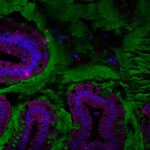Lien vers Pubmed [PMID] – 33673609
Lien DOI – 10.3390/nu13030788
Nutrients 2021 Feb; 13(3):
Obesity, a major public health problem, is the consequence of an excess of body fat and biological alterations in the adipose tissue. Our aim was to determine whether high-intensity interval training (HIIT) and/or α-linolenic acid supplementation (to equilibrate the n-6/n-3 polyunsaturated fatty acids (PUFA) ratio) might prevent obesity disorders, particularly by modulating the mucosa-associated microbiota. Wistar rats received a low fat diet (LFD; control) or high fat diet (HFD) for 16 weeks to induce obesity. Then, animals in the HFD group were divided in four groups: HFD (control), HFD + linseed oil (LO), HFD + HIIT, HFD + HIIT + LO. In the HIIT groups, rats ran on a treadmill, 4 days.week-1. Erythrocyte n-3 PUFA content, body composition, inflammation, and intestinal mucosa-associated microbiota composition were assessed after 12 weeks. LO supplementation enhanced α-linolenic acid (ALA) to docosahexaenoic acid (DHA) conversion in erythrocytes, and HIIT potentiated this conversion. Compared with HFD, HIIT limited weight gain, fat mass accumulation, and adipocyte size, whereas LO reduced systemic inflammation. HIIT had the main effect on gut microbiota β-diversity, but the HIIT + LO association significantly increased Oscillospira relative abundance. In our conditions, HIIT had a major effect on body fat mass, whereas HIIT + LO improved ALA conversion to DHA and increased the abundance of Oscillospira bacteria in the microbiota.


